Vallisneria is a classical aquarium plant also known as eelgrass, tape grass, and Vallis. It is not famous among all aquarium keepers and hobbyists. Vallisneria is widely distributed in Africa, Asia, North America, and Europe. Keep reading the following article for more information about Vallisneria, aquarium plants.
This plant is probably the easiest for hobbyists to grow and it is also one of the oldest aquarium plants. This plant is often confused with another plant called Sagittaria, in order to distinguish between the two you need to check the edges as the edges of Sagittaria are smooth, whereas the edges of Vallisneria have spikes. If you are a beginner then I can recommend starting off with Vallisneria as they grow very easy and fast. Also, they come in different leaf shapes and sizes and look very beautiful in aquariums.
Another fascinating technique to plant it is by planting it at either end of a very long landscaped tank. The airflow forcibly moves its leaves towards the middle of the aquarium.
When planted in clusters in the aquarium’s mid-ground, smaller varieties with coiled and helical leaves can be seen. Before adding it to any aquascape, the speed with which this plant can spread is a significant consideration an aquarist must make.
Vallisneria isn’t the plant for you if you want a low-maintenance aquascape with no trimming. The plants tend to send out runners and sprout across the place.

Table of Contents
Vallisneria Overview
Vallisneria is a classic plant that easily grows in aquariums. It belongs to the Hydrocharitacea family. This plant lives and grows in water and will die if taken out of the water. Therefore, it is called an aquatic plant.
This plant is available worldwide; its mysterious and aesthetically beautiful appearance is meant to enhance the overall look of your aquarium tank. This plant grows well in different climatic conditions and varying temperatures.
| Information Chart | Vallisneria |
|---|---|
| Scientific Name: | Vallisneria sp. |
| Family: | Hydrocharitacea family |
| Care Level: | Easy |
| Growth Rate: | Moderate-Fast |
| Maximum Size: | 8 -16 inches |
| Minimum Tank Size: | 40 liters or 10 gallons |
| Water Conditions: | Moderate |
| Lighting: | Medium |
| Propagation: | By Runners |
| Placement: | Background |
Vallisneria Appearance
A Vallisneria plant typically looks long, thin, and grows with ribbon-shaped leaves, and has spikes on its head. This species creates low vegetation inside the tank. The attractive part of this plant is its leaves which may grow straight or in a twisted form, depending on the available space. It can grow from stalons or runners, which we can view from the substrate top. We can observe other seeds and flowers as these plants grow within the water
Varieties Of Vallisneria Plant
Nearly 30 varieties of Vallisneria species are currently identified, but only a few species are available in aquarium stores worldwide. These species exhibit different characteristics based on the tank size and shape.
Vallisneria Americana
They are also called Gigantea. This plant contains a bulbiform rhizome with small roots; around 12-15 ribbon-like leaves come from this rhizome. This plant grows up to 1m and spreads out 20-35 mm in width. They appear in dark green and grow well in large aquariums because of their size.
Vallisneria Nana
This plant is visible in light green color with thin leaves. The plant resembles grass and grows up to 15 inches high. The plant takes time to grow and is suitable for small tanks.
Corkscrew Vallisneria
This species is also known as Vallisneria torta, and the leaves of the plant can be seen in a twisted form. This plant grows up to 50 cm, and it is one of the largest species in the Vallisneria family.
Vallisneria Spiralis
This species will grow rapidly and occupy the background of the tank with the dense growth. It is also called Straight Vallisneria, and is usually available in 5 longitudinal veins. The minimum height and width it can grow is 50 cm and about 12 mm, respectively.
Vallisneria Fortifolia
This plant species grows up to 6 to 8 inches, appearing in thin and coil forms. Growth will be high in tank areas of 5 to 30 gallons. It is most visible in the green color
Vallisneria Asiatica.
This species grows in short and twisted forms. It can grow up to 12 to 20 inches, and rapid growth is visible in tank sizes of 10 gallons.
Vallisneria Size
A typical Vallisneria grows up to 6 inches on the lower end and 60 inches for larger specimens.
Vallisneria Care and Tank Set-Up
Hobbyists will find it pretty easy to keep Vallisneria in an aquarium as they are very easy to grow, just make sure not to keep them in too soft or acidic water, as this will make them grow slow or even die. These plants grow so well that they require trimming from time to time, otherwise they can cover the whole top of the aquarium, just be careful not to damage the leaves otherwise they will die. To avoid this just trip the tops of the plants with scissors. You can also let them grow to make a shade for small fish.
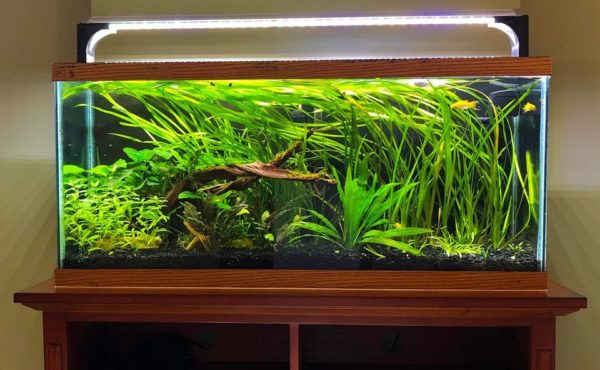
These plants are great for bigger and taller tanks as they can grow very tall till the top and look very nice in taller tanks. Also, they can grow with almost any tank mates. Even though Vallisneria is very easy to grow, some people still seem to have some issues with these plants. If these plants are not growing properly, this may be the result of iron deficiency, lack of nitrates in the water, not stable dosage use of Co2 or if you have planted them too deep, as the top of the plant should be above the substrate.
Vallisneria Tank Size And Specifications
To promote the overall growth of the plant, you need to maintain the optimum values in water, tank size, and best growing conditions. The optimal values are defined below.
Optimum Tank Size For Vallisneria Plant
The recommended tank size for Vallisneria Plant is 10 gallons or 38 Litres.
Tank Shape For Vallisneria Plant
The tank shape required to grow this plant should be rectangular with larger side width.
Filter Type
Vallisneria plants do not require filters for successful growth in the aquarium. However, you can use filters to create a movement in the water. Power filters suit best for this requirement. Anyhow you can select the filter of your choice, but a thumb rule is to opt for a model which can process your aquarium 4 to 6 times in an hour.
Substrate
The Vallisneria plant grows well in a substrate. However, placing the nutrient-rich substrate will work well. Fine ground sand or gravel suits the best for this plant’s growth.
How Many Vallisneria Plants Can Grow In 10 Gallon Tanks?
A minimum of 3 to 4 plants can grow in a 10-gallon tank.
Water Parameters For Vallisneria Plant
Water Temperature
The ideal water temperature for Vallisneria Plant is 15-30oC.
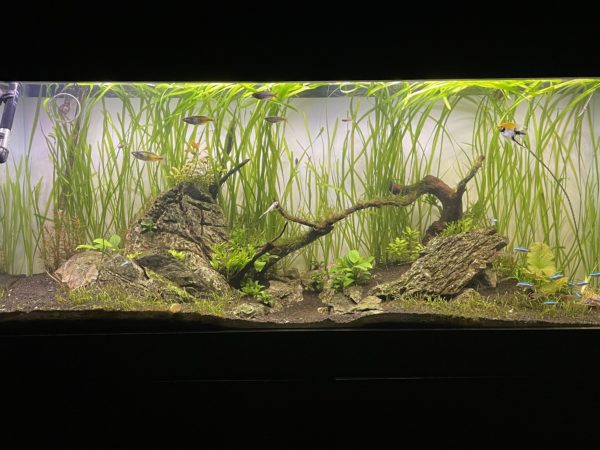
Water Flow Rate
Vallisneria can grow in a wide range of environments, from still water to fast-flowing rivers, depending on its variety. As a result, they are adaptive to almost all water-flow conditions.
Vallisneria looks excellent when it moves at the top of the tank with all branches bent in almost the same direction as the water flow. It can be stunning to watch it in darkroom settings. With the help of a Lily Pipe, you may easily distribute flow. This will allow the plant to move more naturally in the potted aquarium.
Ph Level
The perfect water pH level for the Vallisneria plant is 6.5-8.0 [pH].
Water Hardness
The Vallisneria plant can handle and grow well in hard and soft water. For better plant growth, the hardness of the water should be in the range of 4-18 GH.
Vallisneria Plant Tank Landscape
How To Set Up An Aquarium Tank For Vallisneria?
Vallisneria is a huge aquarium plant with a strong root structure. Use a 3 or 4-inch deep sandy substrate. Use plain, cleaned gravel, aquarium sand, or special enriched aquarium soils to enhance growth.
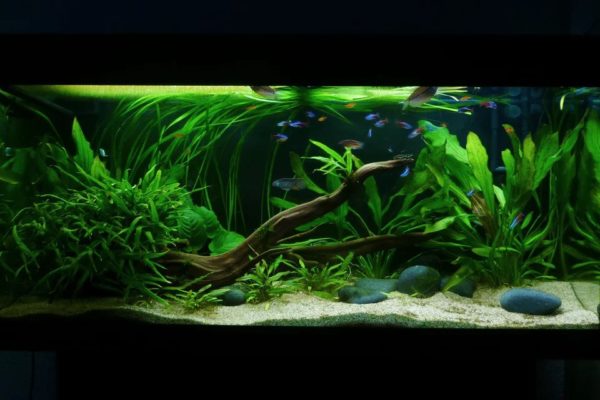
When Vals grow long and sweep across the tank’s surface, they shade out any other plants below, and any leaves that grow out of the water and dry out perish.
Although lesser varieties such as spriralis and tortifolia can be produced in smaller tanks, tank sizes of 15 gallons or less are likely to be the minimum. If the leaves are too tiny, they will fall off easily on the floor space.
But if you have a tall tank then it is recommended to buy Vallisneria Americana which can grow very tall and it perfect for taller tanks. Sometimes it is really hard to distinguish between Vallisneria species as they look different in different places and conditions. So their look can be deceptive sometimes, it is recommended to do a good research about certain species of Vallisneria before buying them.
So if you have decided to grow Vallisneria in your aquarium, then it is a great idea especially when you are a beginner. It will not require much time and effort and will make your aquarium look even better. Also, you have a wide variety of species to choose from for all shape and size tanks. Vallisneria will be an excellent addition to other plants in your aquarium.
Worst Plants For Vallisneria Tanks
Except for floating plants, all other plants are considered the worst for Vallisneria Tanks
Decorations For Vallisneria Tanks
As the Vallisneria plants grow in freshwater, several jungle Vallisneria plants can be used for decoration purposes for Vallisneria tanks.
Lighting For Vallisneria Plants
This plant requires moderate lighting (30-50 PAR). If exposed to high lighting, the plants will grow quickly, and runners will develop rapidly. When exposed to low lighting, the plants will survive but will not grow quickly. Bright lighting encourages the plants to grow greener and boosts their overall growth. Hence, try to maintain suitable lighting within your aquarium for the better growth of your plant.
Vallisneria Compatibility And Tank Mates
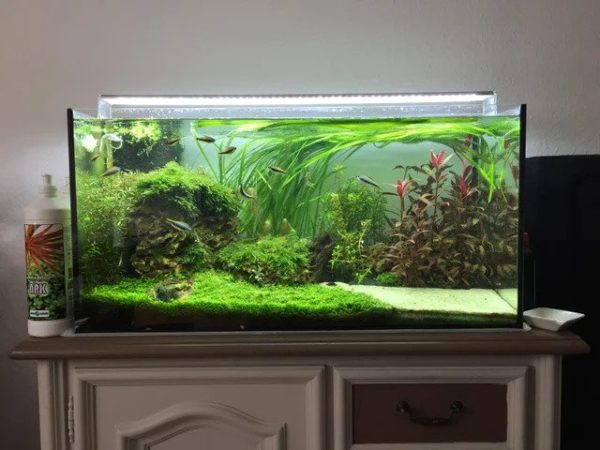
Ideal Tank Mates For Vallisneria
Fishes which can sustain in tropical, cool, and freshwater, are ideal tank mates for Vallisneria plants. Ideal tank mates are mentioned below
- African Cichlids
- Otocinclus Catfish
- Snowball shrimp
- Vampire shrimp
- Ramshorn snails
- Nerite snails
- Guppies
- Rainbowfish
- Platys
- Mollies
Bad Tank Mates For Vallisneria
You should avoid aggressive fishes. The bad tank mates for Vallisneria are listed below
- Crayfish
- Crabs
- Dwarf Sagittaria
- Goldfish
- Clown Loach
- Tropical Tetras like Neon Tetras
- Harlequin Rasboras
Facts About Vallisneria Plant
The important facts about the plants are described below
- Scientific Name: Vallisneria sp
- Other names of the plant are Eelgrass, Tape grass, Vals or Vallis, Wild-celery
- The growth rate of Vallisneria is moderate to high
- The optimal pH is 6.5 to 8.0
- The plant is suitable for placing in the background of the tank
- Medium lighting is required for the growth of the plant
- Maintaining temperature from 20-28°C
- Plants will grow up to 8-16 inches.
Are Vallisneria Plants Right For You?
These plants are suitable for beginners, as they easily grow in freshwater. Many varieties are available, and they appear in green with twisted and coiled leaves. It acts as a decorative piece to the aquarium.
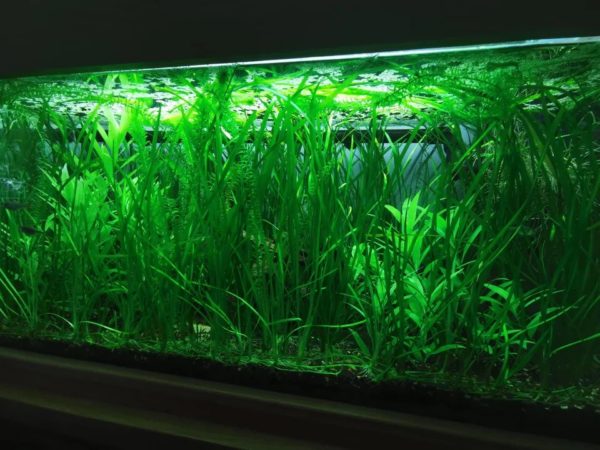
FAQs
What Are The Benefits Of Having Vallisneria In Your Aquarium?
The main benefits of having the Vallisneria plants are mentioned below.
- Reduces the growth of algae
- Improves the quality of the water
- Provides safety and security to the shy fishes
- Hardiness
- Good for aquascaping
How To Grow A Vallisneria Plant In Your Aquarium?
Set the plant’s roots in the substrate to start growing Vallisneria. It is advisable to add a 3-inch layer of sand, gravel, or aquarium dirt.
Once planted in the aquarium, Vallisneria grows quickly. The plants may go through a phase of melting that lasts a few days or weeks before bouncing back and resuming their normal growth rate.
Can We Grow A Vallisneria Plant Easily?
Vallisneria is a fairly simple freshwater plant to cultivate, so it is popular among both novice and experienced growers. Vallisneria is sometimes too easy to grow, and keeping that from sweeping over can keep you busy.
The most unique and interesting fact about these aquarium plants is that they can grow flowers and produce seeds, which is rare among aquarium plants. Vallisneria has male and female plants. Female plants can produce flowers, the flowers usually float on the surface of the aquarium, and male plants produce flowers underwater, which get released and then float to the surface and meet flowers produced by female plants. This is when pollination happens, after which seeds are produced.
Can We Add Fertilizer To Grow Vallisneria Plants?
They make excellent starting plants for novice aquarists, allowing you to get your hands wet. The plant maintenance is low, as it does not require fertilizer or CO2 if nutrients are accessible from fishes or crustaceans. They’re inexpensive and come in a range of altitudes and patterns, adding interest to your tank without detracting the beauty of the aquarium and fish.
Conclusion
Vallisneria plants are a great addition to tanks, adding a subtle elegance while benefiting your fish. These grassy plants will attract various fish species, which will use them for breeding and shelter.
They make excellent starter plants for new aquarists, allowing you to get your feet wet. They are low-maintenance plants that do not require fertilizers or CO2 addition to the water. The nutrients required for the growth are available from fish or invertebrates. They’re very cheap and come in various altitudes and patterns, adding interest to your tank without deviating from your fish’s attractiveness.
Keeping aquatic plants can be frightening, but Vallisneria plants can make it less so.
Overall, this plant best suits beginners as they grow easily with minimum care. This plant can tolerate high temperatures. It’s a great-looking plant that makes the environment look green by creating an underwater jungle where animals and plants can survive.
Have you got any questions? Join us in the conversation by leaving the comments or your personal experiences below.
